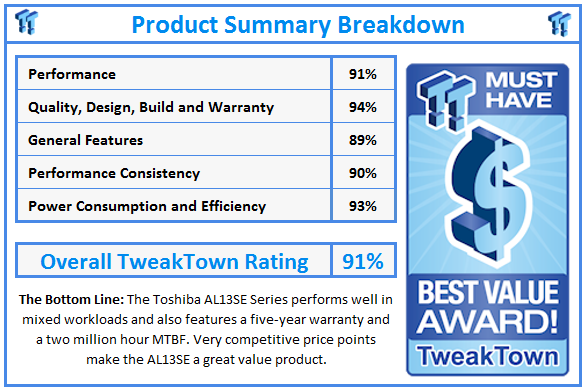Introduction

The Toshiba AL13SE HDD Series is geared for use in mission-critical server and storage applications. The AL13SE comes in capacities of 300, 450, 600, and 900 GB in a 2.5-inch form factor. The drive features a SAS dual-port 6 Gb/s connection and a 64MB FIFO cache buffer. The Toshiba AL13SE spins at 10,500 RPM and features an average latency of 2.8ms.
The pressure from SSDs has forced the performance segment of the HDD market to be more competitive in terms of performance and price. We are continuing to observe plenty of market activity with the performance HDD segment in spite of the fact that many are predicting 2.5-inch drives will be usurped from the datacenter by SSDs.
IDC predicts the HDD TAM (Total Available Market) for the performance category (10k and 15k) will be double that of the SSD market by 2016. HDDs still hold a price versus capacity advantage, and we do not expect the HDD manufacturers to cede that market easily. Look for increased price competitiveness in the HDD performance segment in the future as the HDD crowd attempts to stave off the SSD invasion.
Users typically move to 10K HDDs for their faster speed, and the AL13SE is the first of Toshiba's 10k HDDs to employ a dual-stage head positioning actuator that provides a 32 percent increase in its sustained transfer rate. The SAS interface provides enhanced HA (High Availability) multipath, failover functionality, an average read seek time of 3.7 ms, and an average write seek time of 4.1.
One of the greatest advantages of 2.5-inch HDDs is their lower power consumption during operation. The AL13SE series also utilizes Supported Enhanced Power Condition State (SEPCS) to lower the RPM idle speed. SEPCS drops the idle power to 4.0 watts when the drive is not in use. We test the operational power of the drive in the following pages.
Backwards compatibility is important, and the drive features the industry-standard 512-byte sector size. There is also the notable inclusion of a SlimFITT (AL13SEL) version with a 3.5-inch adapter for deployment in 3.5-inch drive bays.
Reliability is a major factor in purchasing decisions, and the AL13SE features an improved head-disk proximity sensor that helps deliver a 2,000,000-hour Mean Time Before Failures (MTBF) rating. This is a 25 percent increase over previous-generation drives. The AL13SE is backed by an industry standard five-year warranty.
The Toshiba AL13SE has made its way into mid-range volume servers, mainstream storage arrays, blade, and rackmount servers and is primarily intended for mission-critical, power-conscious, and data intensive systems.
AL13SE Internals and Specifications
AL13SE Internals


The Toshiba AL13SEB900 comes in the standard 2.5-inch 15mm form factor.

The AL13SE features a Marvell i9335-01 controller and a Texas Instruments drive-motor controller. There is also a Winbond cache module at the top of the PCB.

AL13SE Specifications
The 2.5-inch 10,5000 RPM AL13SE comes in capacities of 300, 450, 600, and 900GB. An optional model, the AL13SEL, comes in a drive bay converter for use in 3.5-inch bays.

Test System and Methodology


Our approach testing storage is specifically designed to target long-term performance with a high level of granularity. Many testing methods record peak and average measurements during the test period. These average values give a basic understanding of performance, but fall short in providing the clearest view possible of I/O Quality of Service (QoS).
'Average' results do little to indicate the performance variability experienced during actual deployment. The degree of variability is especially pertinent as many applications can hang or lag as they wait for I/O requests to complete. This testing methodology illustrates performance variability and includes average measurements during the measurement window.
While under load, all storage solutions deliver variable levels of performance. While this fluctuation is normal, the degree of variability is what separates enterprise storage solutions from typical client-side hardware. Providing ongoing measurements from our workloads with one-second reporting intervals illustrates product differentiation in relation to I/O QoS. Scatter charts give readers a basic understanding of I/O latency distribution without directly observing numerous graphs.
Consistent latency is the goal of every storage solution, and measurements such as Maximum Latency only illuminate the single longest I/O received during testing. This can be misleading as a single 'outlying I/O' can skew the view of an otherwise superb solution. Standard Deviation measurements consider latency distribution, but they do not always effectively illustrate I/O distribution with enough granularity to provide a clear picture of system performance. We use histograms to illuminate the latency of every single I/O issued during our test runs.
We measure power consumption during test runs. This provides measurements in time-based fashion, with results every second, to illuminate power consumption behavior. This significantly affects the TCO of the storage solution. We also present IOPS-to-Watts measurements to highlight the efficiency of the storage solution.
We conduct our tests over the full LBA range to allow each HDD to highlight its average performance. Short stroking can increase performance at the loss of capacity. The Seagate v7 series only comes in a capacity of 1.2TB, while the v6 series offers similar performance but smaller capacities of 300, 450, 600 and 900GB. The first page of results provides the 'key' to understanding and interpreting our test methodology.
4k Random Read/Write

Each queue depth (QD) for every parameter tested includes 300 data points (five minutes of one second reports) to illustrate the degree of performance variability. The line for each QD represents the average speed reported during the five-minute interval.
4k random speed measurements are an important metric when comparing drive performance as the hardest type of file access for any storage solution to master is small-file random. One of the most sought-after performance specifications, 4k random performance, is a heavily marketed figure.
The Toshiba AL13SE averages 394 IOPS, while the Seagate v7 leads the heavy 4k read workload with an average of 410 IOPS at QD256.
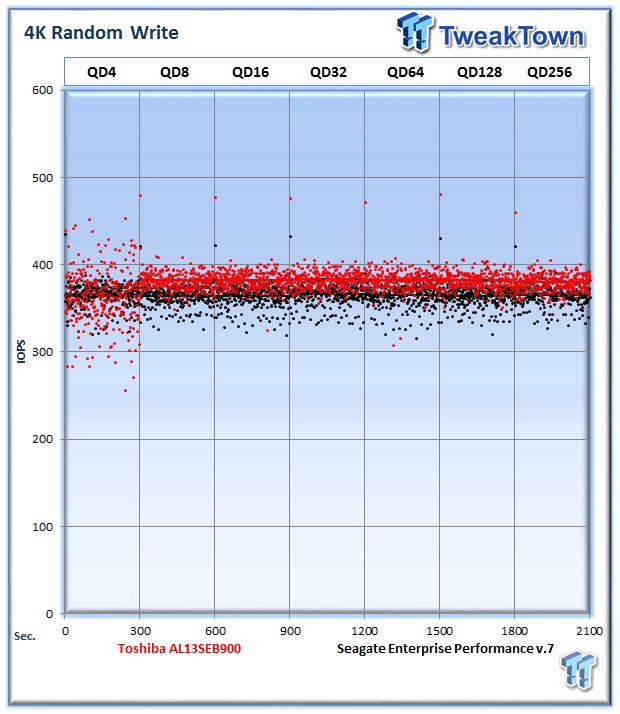
The AL13SE averages 380 IOPS at QD256 to take the lead, while the v7 averages 365 IOPS.

Our write percentage testing illustrates the varying performance of each solution with mixed workloads. The 100 percent column to the right is a pure write workload of the 4k file size; 0 percent represents a pure 4k read workload.
The AL13SE slightly trails the v7 from 0-20 percent but takes the lead as we mix in a heavier write workload.
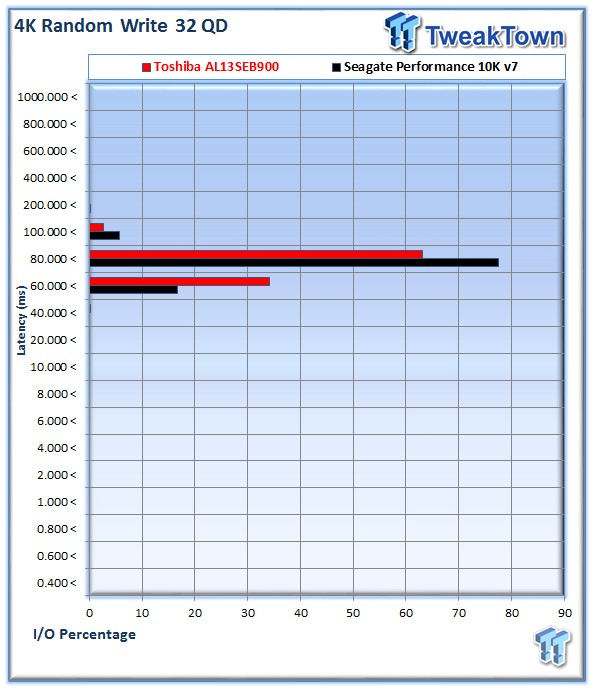
The AL13SE provides more commands in the 60-80ms range than the v7 in this heavy write workload.

We record the power consumption measurements during our test run at QD256.
The AL13SE pulls 6.78 watts during the measurement window, just slightly higher than the v7, which averaged 6.88W.


IOPS to Watts measurements are generated from data recorded during our test. The AL13SE leans on its ever-so-slightly lower power consumption and faster write speed to deliver more IOPS per Watt in the 4k random write workload, and the roles reverse with the v7 taking the lead in the read category.
8k Random Read/Write

8k random read and write speed is a metric that is not tested for consumer use, but is an important aspect of performance for enterprise environments. With several different workloads relying heavily upon 8k performance, we include this as a standard with each evaluation. Many of our Server Emulations below will also test 8k performance with various mixed read/write workloads.
The Toshiba AL13SE delivers an average of 389 IOPS at QD256, falling slightly to the Seagate v7's average of 404 IOPS.

The average 8k random write speed of the AL13SE is 377 IOPS at QD256. The v7 measures a lower 361 IOPS at QD256, with the two drives again flip-flopping positions from read to write testing.

The AL13SE scores very well as we mix in more write activity, with the tipping point occurring at a 30 percent write mixture and continuing until it is a full 100 percent write workload.

The AL13SE nudges the v7 with a slightly lower latency range with write activity.

The difference in power consumption for the AL13SE and the v7 is nearly indistinguishable in this test, with less than 0.1 watts separating the two drives.


The two drives again trade blows with efficiency. The AL13SE leads in write workloads, while the v7 leads in read workloads. This is rather predictable considering the performance results above.
128k Sequential Read/Write

The 128k sequential speeds reflect the maximum sequential throughput of the HDD using a realistic file size encountered in an enterprise scenario.
The Toshiba AL13SE averages 184 MB/s of sequential read speed, while the Seagate v7 takes the lead with its average of 195 MB/s.

The AL13SE averages 182 MB/s of sequential write speed, and the Seagate leads again with 195 MB/s.

Though the AL13SE trails in the pure read and write workloads, we can see that it handles mixed read/write data very well and dominates the middle of the chart.

The Seagate v7 provides lower latency during the 100 percent write testing.

The Seagate v7 draws more power during the write test, but the IOPS to Watts testing reveals this is in line with the increase in performance.


The AL13SE and the v7 deliver similar test results in IOPS per Watt testing for sequential data, proving that the slightly higher power consumption of the v7 is offset by the increased performance.
Database/OLTP and Web Server
Database/OLTP

This test emulates Database and On-Line Transaction Processing (OLTP) workloads. OLTP is in essence the processing of transactions such as credit cards and high frequency trading in the financial sector. Enterprise HDDs are uniquely well suited for the financial sector with their low latency and high random workload performance. Databases are the bread and butter of many enterprise deployments. These are demanding 8k random workloads with a 66 percent read and 33 percent write distribution that can bring even the highest performing solutions down to earth.
The AL13SE and the v7 are nearly too close to call, with only 2 IOPS separating the two drives in this test.

The performance results were roughly the same, but the v7 leads in latency during the test.

The AL13SE averages 7.71 watts during the test period, with the v7 slightly besting it with a 7.56W average.

The efficiency of the two drives is nearly too close to call, with the drives again separated by a mere few IOPS.
Web Server

The Web Server profile is a read-only test with a wide range of file sizes. Web servers are responsible for generating content for users to view over the Internet, much like the very page you are reading. The speed of the underlying storage system has a massive impact on the speed and responsiveness of the server that is hosting the website and the end-user experience.
The v7 takes the lead in this read-centric test with 399 IOPS, while the AL13SE trails with 381 IOPS.

The v7 takes a lead in latency during the test, showing its great performance in heavy read workloads.

The AL13SE averages 8.22 watts during the test, but differences are minute between the two drives.
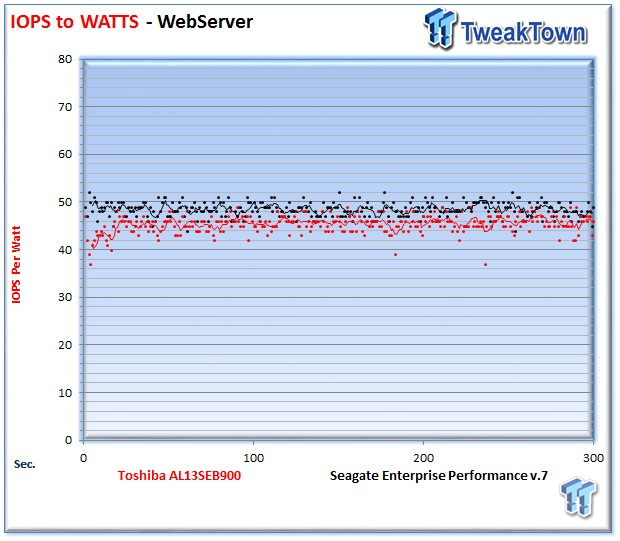
The v7 leans on its better performance in this mixed read workload to deliver a slightly higher efficiency.
File Server and Email Server
File Server

The File Server profile represents typical file server workloads. This profile tests a wide variety of different file sizes simultaneously, with an 80 percent read and 20 percent write distribution.
The AL13SE averages 514 IOPS at QD256, while the v7 leads with an average of 527 IOPS.
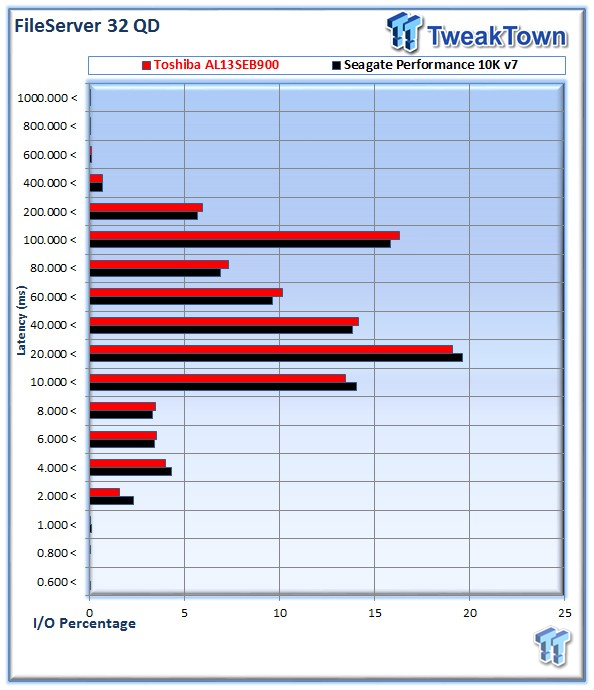
The v7 takes a slight lead in latency performance.


The AL13SE and the v7 end up with remarkably similar performance characteristics in the power and efficiency category.
Email Server

The Email Server profile is a very demanding 8k test with a 50 percent read and 50 percent write distribution. This application is indicative of the performance of the solution in heavy write workloads.
This heavy write workload brings the AL13SE a win with its average of 391 IOPS besting the 383 IOPS from the v7.

The AL13SE once again exhibits great performance in write-centric random workloads with more commands serviced in the lower latency range.


The difference between drives is once again nearly indistinguishable in the power and efficiency testing.
Final Thoughts

Toshiba has been spinning HDDs for over 47 years, and they delivered their first 14-inch 7.25MB hydraulic HDD in 1967. Fast forward 37 years and Toshiba offers HDDs in all speeds for every enterprise workload. Luckily, the HDDs of today are much smaller. Toshiba has progressed down to a capacity of 900GB in a 2.5-inch form factor with an areal density of 856Mbit/mm2 for the AL13SEB900 we evaluated today. There is no hydraulic fluid required, and the cache alone has more capacity than their original HDD.
The dual-port SAS AL13SE series is designed for heavy workloads in mission-critical environments. Its small 2.5-inch form factor allows its use in slim servers and other applications where 3.5-inch HDDs simply are not practical. 2.5-inch HDDs also bring along performance and power consumption improvements. Those looking to integrate the smaller HDDs into existing infrastructure can purchase a model pre-installed into a 3.5-inch drive bay converter.
In our testing, the AL13SE showed a preference for random write workloads. In our 4k and 8k testing, the AL13SE excelled in the middle ranges as we mixed in heavy write workloads. This is a good omen for performance in heavy mixed workloads, but the drive trailed the v7 in our pure random read tests. To see if the mixed performance equated to better scores in applications, we turned to our server emulations. The AL13SE tied the Seagate v7 in OLTP and email server tests, but took a slight loss in the file server profile. The Seagate v7 tended to excel in random read workloads, which led to it winning the web server test by a considerable margin.
Sequential read and write speed were a bit disappointing on the surface as the Seagate v7 easily took the lead over the AL13SE. Further testing revealed that the Toshiba drive performed much better in mixed sequential workloads, delivering a dominating performance in our write percentage testing. As with most of the tests, the AL13SE performs well in mixed workloads.
In power consumption and efficiency testing, the AL13SE again showed an affinity for write activity with a higher IOPS to Watts average in those workloads. The Seagate v7 took the win in read workloads. The results were too close to call in many of the mixed workloads, and the differences were slight where we recorded variances.
With the two drives so close in most performance metrics, many other aspects of the drive will come into consideration when it comes to making a purchasing decision. The Toshiba AL13SE and the Seagate v7 share other characteristics as well, with both providing a similar MTBF rating of 2,000,000 hours and a five-year warranty.
The Seagate v7 has a notable advantage in the capacity department at 1.2TB, and the Seagate v6 series offers similar performance at smaller capacities mirroring those of the AL13SE. For those looking for moderate capacity points, the AL13SE will make an attractive choice for write-centric mixed workloads. With such close performance metrics in many aspects, much of the decision will likely be determined by price, where the AL13SE series seems to hold the advantage at this point.
PRICING: You can find the Toshiba AL13SE for sale below. The prices listed are valid at the time of writing but can change at any time. Click the link to see the very latest pricing for the best deal.
United States: The Toshiba AL13SE (900GB) retails for $304.95 at Amazon.
Canada: The Toshiba AL13SE (300GB) retails for CDN$316.70 at Amazon Canada.

